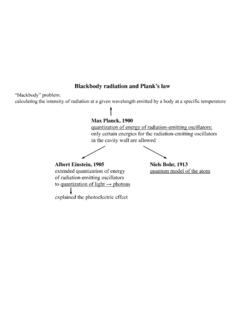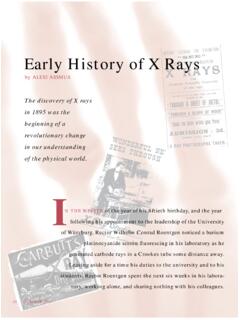Transcription of Analysis of standing vertical jumps using a force platform
1 Analysis of standing vertical jumps using a force platformNicholas P. Linthornea)School of Exercise and Sport Science, The University of Sydney, Sydney, New South Wales, Australia~Received 9 March 2001; accepted 8 May 2001!A force platform Analysis of vertical jumping provides an engaging demonstration of the kinematicsand dynamics of one-dimensional motion. The height of the jump may be calculated~1!from theflight time of the jump ,~2!by applying the impulse momentum theorem to the force time curve,and~3!by applying the work energy theorem to the force -displacement curve. 2001 AmericanAssociation of Physics Teachers.@DOI: #I. INTRODUCTIONA force platform can be an excellent teaching aid in un-dergraduate physics classes and laboratories. Recently,Cross1showed how to increase student interest and under- standing of elementary mechanics by using a force platformto study everyday human movement such as walking, run-ning, and jumping.
2 My experiences with using a force plat-form in undergraduate classes have also been highly favor-able. The aim of this article is to show how a force platformanalysis of the standing vertical jump may be used in teach-ing the kinematics and dynamics of one-dimensional use computer software that produces curves of velocity anddisplacement of the jumper s center of mass by numericalintegration of the force time record from a force platform . Asimultaneous examination of these curves gives an effectiveillustration of the relations between the forces acting on abody and the resulting acceleration, velocity, and displace-ment of the curves obtained from the force platform may also beused to calculate the height of the jump , and three methodsare presented here.
3 The most straightforward method is todetermine the time spent in the airborne phase and then usethe kinematic equations for one-dimensional motion underconstant acceleration. A more accurate method of determin-ing the jump height is to apply the impluse momentum theo-rem to the force time record, and this provides an interestingexample of numerical integration. The jump height may alsobe calculated by applying the work energy theorem to theforce displacement curve, again using numerical force PLATFORMF orce platforms have a wide range of applications, includ-ing automobile crash tests, clinical gait Analysis , and sportstechnique Analysis . A force platform is a rectangular metalplate, usually about m, with piezoelectric orstrain gauge transducers attached at each corner to give anelectrical output that is proportional to the force on the force platform systems for analyzing humanmovement cost $10 000 $30 000, but with relatively modestexpertise a Department of Physics could construct one forabout $ ,2A platform measures the force exerted on itby the subject, and according to Newton s third law of mo-tion this also gives the force exerted by the platform on thesubject.
4 In terrestrial human movement, the force exerted bythe platform on the body is commonly called the groundreaction force . The jumps discussed in this article we recorded using aKistler force platform that was set in concrete in the floor ofour teaching vertical component of theground reaction force of the jumper was sampled at 1000 Hzand recorded by an IBM compatible PC with a Windows 95operating system. Data acquisition and Analysis of the jumpswere performed using a custom computer program~JUMPANALYSIS!that was written usingLABVIEW virtual instru-ment standing vertical JUMPSF igure 1 shows the motions involved in a countermove-ment jump and in a squat jump . In a countermovementjump, the jumper starts from an upright standing position,makes a preliminary downward movement by flexing at theknees and hips, then immediately and vigorously extends theknees and hips again to jump vertically up off the ground.
5 Acountermovement jump is an example of a movement thatbenefits from the stretch shorten cycle. Many humanmovements such as running, jumping, and throwing involvemuscle actions in which the desired motion is preceded by amovement in the opposite direction. The muscles are said tobe pre-stretched before shortening in the desired have demonstrated that a pre-stretch enhancesthe force production and work output of the muscles in thesubsequent a squat jump , the jumper starts from a stationary semi-squatted position then vigorously extends the knees and hipsto jump vertically up off the 1~b!#. The jumperdoes not employ a preliminary downward phase~ , a coun-termovement!and so the jump does not involve pre-stretching of muscles. The squat jump is a slightly artificialmovement that is rarely used in practice.
6 The only examplethat comes to mind is the takeoff phase in ski-jumping. Thecountermovement jump is a much more natural jumpingmovement and most people can jump several centimetershigher in a countermovement jump than in a squat my introductory mechanics classes, a skilled jumper isasked to perform countermovement jumps and squat jumpswith maximum effort while standing on the force vertical jumps may be performed with and without11981198Am. J. ~11!, November 2001 2001 American Association of Physics Teachersthe aid of armswing. In the jumps examined here, the jumperkept his hands on his hips throughout the force , ACCELERATION, VELOCITY, ANDDISPLACEMENTD uring a vertical jump , the jumper must overcome bodyweight, and the resultant force acting on the jumper s centerof mass~ !
7 IsFGRF2mg, whereFGRFis the ground reac-tion force acting on the jumper,mis the jumper s mass, andgis the acceleration due to gravity. Curves of force time,acceleration time, velocity time, displacement time, andforce displacement are calculated from the ground reactionforce record obtained from the force platform . The timerecord of the resultant force acting on the jumper s iscalculated by subtracting the jumper s body weight from theground reaction force record. The velocity time record isobtained by dividing the resultant force time record by thejumper s body mass to give the acceleration time record,and then numerically integrating with respect to time usingthe trapezoid rule. The displacement time record is obtainedby numerically integrating the velocity time record, againusing the trapezoid rule.
8 Higher order integration proceduressuch as Simpson s rule do not improve the precision of thecalculated parameters integration calculations require that the velocity andvertical height of the jumper s be known at some in-stant. I use the start position of the jump , where the velocityof the jumper s is zero and the vertical height is set tozero. In theJUMP Analysis program, the start of the jump isselected by moving a cursor along the force time curve. Itmust be stressed that the velocity and displacement calcula-tions are very sensitive to the initial conditions. For accuratecalculations there must be a short period before commencingthe jump where the jumper is completely motionless. Thisensures that the ground reaction force at the start of the jumpis precisely equal to the jumper s body weight and that theinitial velocity is zero.
9 It is not difficult to remain motionlessin the standing position before the start of a countermove-ment jump . However, in a squat jump the jumper commencesfrom a crouched position, and some jumpers require consid-erable practice to ensure that they produce a period of nomotion before commencing the upward phase of the jumpand that there is no initial downward ~a! 2~e!showcurvesofforce time,acceleration time, velocity time, displacement time, andforce displacement for a countermovement jump . In theJUMP Analysis program, a cursor may be moved along theforce time curve and the corresponding points on the othercurves are indicated as the cursor is moved. Although verti-cal jumping is a relatively simple movement skill, the phys -ics of the vertical jump is not immediately obvious.
10 Studentsfind a simultaneous examination of the curves to be an illu-minating exercise. The students carefully trace the evolutionof the jump while identifying the key times and phases. Theyare asked to describe the actions of the jumper and note therelations between the force acting on the jumper and theresulting acceleration, velocity, and displacement of thejumper s The key times and phases during the jump areindicated in Figs. 2~a! 2~e!by the lettersatoh, and theseare discussed in the 3 shows a squat jump performed with the samevertical pushoff range as in the countermovement jump . Thatis, the height of the jumper s at the start of the squatjump was the same as the height of the at the lowestpoint of the countermovement jump .







